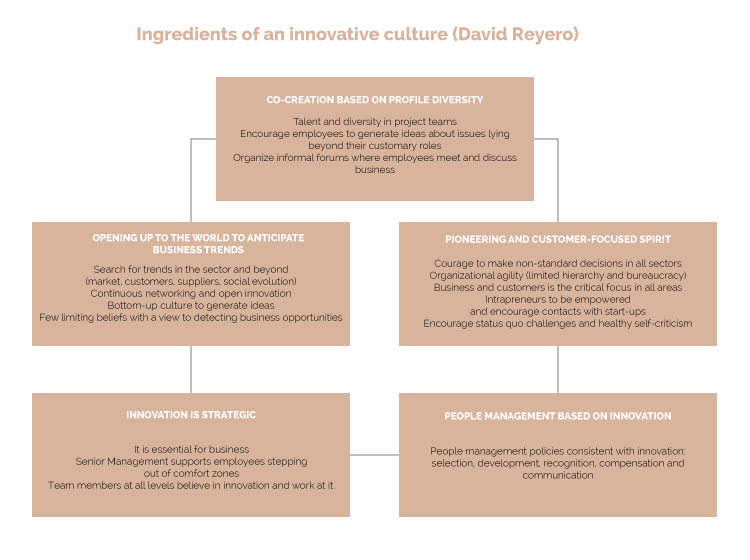David Reyero – Pharma Market – December 2013
Innovation: something that many organizations attempt, but few achieve
Since the beginning of my professional career, I have considered innovation to be a critical issue for long-term business success and I believe that there is a growing consensus in the market as to its strategic importance.
Over time, I have reached three further conclusions on the basis of my own professional experience in different sectors and companies and through numerous conversations and much reading on the subject:
– business strategies in different sectors tend to “dangerously”, resemble each other with but a few exceptions. This is indicative of a low level of innovation and a fear of stepping out of our comfort zones.
– what really makes a difference is to create an organizational culture that will carry innovation in its DNA, as it is much more difficult to copy than a new product or service.
– Although it is very difficult to achieve a truly innovative and sustainable culture, given the existence of numerous barriers, there are a few examples of companies that have succeeded in doing so.
In the present article, I will try to provide an in-depth look at why it is difficult to innovate in a sustainable manner and propose a model dealing with the key areas to be addressed when implementing and managing a powerful innovation culture.
The multiple barriers to innovation
Incremental innovation and disruptive innovation lead us to question the internal status quo and therefore pose very different types of limitations within the company framework. Here is a non-exhaustive list of factors that put the brakes on innovative initiatives.
– Strategic:
Few companies are able to effectively manage their business with innovation since they all require a different type of focus, and innovation frequently ends in failure. We also often focus on the short term and on a search for solutions within the traditional “core business” of what we know we do well.
Furthermore, we do not always deeply analyse the elements which are essential for innovation: the business model (the sources of added value which make customers purchase from us) and the company’s key capacities (know-how, know-who, resources, brand reputation, culture…)
This tends to involve insufficient courage and disruptive mentality to suitably prepare the future with new business approaches, both in times of stability and periods of transformation. This continuous reinvention is one of the fundamental features of century-old companies (General Electric) or outstanding examples of innovation (Apple or Google)
– Cultural:
The inbreeding and excessive hierarchy that limits agile decision-making, the lack of diversity in teams and multi-departmental implication in strategic projects, the fact that experimentation is not encouraged and errors are excessively penalized, the limited focus on a particular sector when seeking business opportunities, excessive analysis and the lack of elements such as intuition prior to making decisions or the fear of breaking moulds are examples of management styles that hinder the creation of innovative cultures.
– People management policies:
The decisions regarding selection, development, recognition or communication are not well in line with innovation and this causes work-teams to question their real importance and the need to make a special effort to achieve their objectives.
Here are a few questions for reflection on the matter: Are innovation and risk-taking sufficiently acknowledged? Is innovation remunerated in terms of variable pay scenarios? Do we have the courage to select professionals from other sectors (especially in strategic positions) to boost innovation? Is innovation an important professional development criterium? Does internal or external communication give enough importance to innovation? Is anti-innovation behaviour penalized (in terms of bonuses, promotions or other measures)? I believe that, in most companies, the answers are still clearly negative.
Elements for a winning organizational culture in terms of innovation
Despite the aforementioned difficulties, there are indeed companies that are capable of being systematically more innovative than their competitors. They are companies that draw our attention because they do things “differently.”
Some examples of successful approaches:
– Senior management devotes part of its time to broaching innovation in order to systematically anticipate competition and encourages lower-level employees to adopt its approaches and to implement them.
– There are clear strategic objectives as to what is expected of innovative initiatives.
– They do not penalize errors, but consciously encourage them. They are well aware that this will give rise to true innovation.
– Maximum diversity is sought in project teams so that the “creative tension” will give rise to better solutions.
– Employees are acknowledged for their innovative ideas and receive encouragement.
– If an innovative idea is found, swift decisions are made to assess whether it gets the go-ahead and may be assigned resources to be tested.
– The managers are innovative as previous selection and promotion processes have been correctly applied to make this happen.
– Whoever hampers innovation is economically and culturally penalized
– Organizational culture encourages constructive criticism, mould-breaking or, at least, advanced ideas on new solutions for customers.
– There are few limiting beliefs and data are used, but so is intuition.
– “The thing is that…” is replaced by “It is necessary to…” in the context of decision-making.
– The support, research or production departments do their utmost to make things easier for the commercial teams.
– They co-create innovation policies beyond the company’s frontiers: they collaborate with competitors, customers, suppliers, universities and other institutions as they know that an I+D+I that aims to be different cannot merely be supported by internal resources.
In the following systematic model you can appreciate the main elements that make a difference, on the basis of both my own personal experience and international articles such as “The Innovator’s DNA” by Jeffrey H. Dyer, Hal B. Gregersen, and Clayton M. Christensen, published in the Harvard Business Review (December 2009).
Conclusions
Experts say that “culture is, above all, what an organization dedicates most of its time and money to”, as it pervades real everyday corporate values and informs the employees as to what is truly important.
I therefore believe that, if a company wishes to have innovation in its DNA, it should accept that success will only be achieved by stepping out of comfort zones and accepting uncertainty and failure as frequent travel companions. This will not be an easy task if managers are not exemplary in their innovative behaviour, if the business focus is inbred or if people management policies are not consistent with innovation in all its dimensions. And neither must we forget good old common sense, which is often a great source of innovation which we tend to neglect.
Innovation is a very complex issue, but it is worth the time and energy. It is not a “pretty philosophy” but rather a clear business imperative for survival in most economic sectors. One of the strategic slogans of a globally successful company like Google inspires us to be bold and to innovate: “If you can dream it, you can do it”.

Leave a Reply